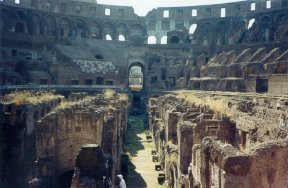

The Colosseum was the first stone amphitheater - begun in 72 AD (Vespasian's reign) and finished in 80 AD, it only took 8 years!. It's inauguration lasted for 100 days and nights and over 5,000 wild animals were killed. The Colosseum is elliptical in shape and has a diameter of 620 feet at it's widest section and 490 feet at it's narrowest section. It stands 165 feet high. There was room to seat approximately 70,000 spectators. At the top of the outside wall were "shelves" which supported wooden poles over which the "velarium" or a linen and silk awning was unfolded over the entire amphitheater to shade the people from the sun. This awning was painted like the sky. A special detachment of the navy was stationed there to control and unfurl the cloth. To this date we are unable to reproduce the mechanisms and the techniques used to unfold an awning of this size.
During its early years, the center of the Colosseum was empty - allowing it to be filled with water where small naval battles were fought. The center area was eventually filled with walls and passages which were covered by a large wooden floor. The remains of elevators which lifted gladiators and animals to the surface through trap doors in the flooring can be seen in the picture. The scenery could be quite extensive for these fights - including entire forests to hunt in, sand over the flooring to soak up blood, and occasionally the sand would be mixed with gold and silver dust for a dazzling effect. The people in the Colosseum could have final say in the life and death of some of the gladiators by giving the famous thumbs-up to live or thumbs-down to die. Even when dead, hot metal pokers were used to be sure the dead were indeed dead.
A metal fence surrounded the entire gladiator floor. This fence had circular tubes over the wiring which rolled, making it very difficult to keep your foothold if you tried to climb it. Should one succeed in getting to the top and over the fence, archers were stationed throughout the circumference to shoot down the spectators who tried to get into the arena.
Originally, marble seats all the way up to the top of the outer most wall covered the entire Colosseum. This created covered halls through which the people moved to their respective seats. There were over 80 entrances to the Colosseum and multiple corridors to get to the seats. Many fires broke out over the years, but amazingly the Colosseum was so well designed that not one person ever died in a fire or and evacuation.
The entire Colosseum was covered in white marble which was attached with iron clamps (or in some areas covered in stucco instead). The multiple holes in the walls show where the iron clamps were placed. When Rome fell into hard economic times (approximately 664 AD) the marble and iron were removed and reused for other buildings and temples. All that remains to be seen today is the skeleton of the building. Blocks of tufa (a very strong volcanic rock) were one of the major support columns used in the building. The rest of the building was made of brick with arches extending out from the tufa columns - thereby distributing the weight of the walls toward the columns for addition strength and to lower the building cost. Of the outer most wall, only two fifths remain standing.
In 1744 the removal of materials was ended when the Colosseum was dedicated to the Christians which supposedly died there. An iron cross was erected during this time. In fact, there is no evidence which supports the common belief (and multiple movies made) that the Romans put hundreds of Christians to death in the Colosseum by gladiators and wild animals. ALL sorts of people were put to death - slaves, enemies of the State, criminals and yes, some Christians. The last time the Colosseum was used was in 523 AD.